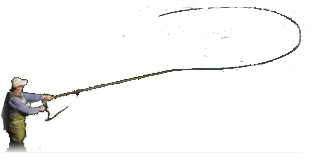-
Two Questions
Here is a question that have been bugging me for a while. It is absolutely unimportant but I would like to know when you reclassify a wooly worm into a wooly bugger based on the length of the tail. Just how long does that tail have to be before the fly changes from a worm to a bugger?
Question two deals with the weight of wire: What is the ratio of weight of solid brass wire compared to lead wire?
Thanks
Tim Anderson
-
a quick google search yielded lead's density approx 1.3x that of drawn brass.
this was just a quick and dirty search and rough math so you may want to follow up and verify the info
-
The main difference between the Woolly Worms and Woolly Buggers is that on a Woolly Worm the palmered hackle is palmered so the hackle slants forward towards the eye of the hook and on a Woolly Bugger the hackle is palmered slanting toward the tail.
Hope this helps.
-
I thought the difference between woolly buggers and worms were the tails. Buggers use marabou, and worms use red yarn or red chinese hackle.
-
Ditto. The long marabou tail on a Wooly Bugger that dances in the current is the main difference. The tail on a Wooly Worm is relatively insignificant.
-
I thought a bugger with the hackle slanted forward and no tail was a crackle back. A fine fly IMO :wink:
According to my pattern books a wooly worm uses stub of yarn for the tail and a bugger has a lengthier marabou tail.
-
yeah in the book that came with my kit the bugger has a big poofy tail and the worm just has stub. my classification is that on a bugger, the tail is big and fluffy, but on a worm, it is short not as....cant think of a word....marabouish i guess...lol.
-
According to the book, "Woolly Wisdom" by Gary Soucie:
"By almost universally accepted definition, the prototypical Woolly Worm has a cylindrical body of chenille (wool yarn, if we go back a few centuries) over the length of which is palmered a forward slanting hackle (usually grizzly, but even some sticklers will allow badger or furnace), all of it usually tied on a long, or at least longish, hook. (Shank length, lack of body taper, and barb angle are the major distinctions between the Woolly Worm and the otherwise very-much-look alike Palmer Flies.) Most of us classify the Woolly Worm as a wet fly; others think it's more nymph, and some few iconoclasts call it a streamer. It can be fished all three ways, and there are dry-and waking-fly versions as well."
Russell Blessing's description of a Woolly Bugger:
"Except for that long, full marabou tail, the Woolly Bugger looks much like a Woolly Worm. The only other differences are, the Bugger's hackle is palmered more closely and the barbs need not angle forward."
-
Bet you didn't think you were opening up such a can of (wooly)worms, did you? :shock:
-
Bluegill222 said: "Bet you didn't think you were opening up such a can of (wooly)worms, did you?".
Yes I did. I figured I would get a variety of opinions. This question was asked of me by a cousin who is just into fly tying. I was showing him a wooly whatever I use on crappie that has a marabou tail cropped to about half way between a bugger and a worm. To add fuel to the fire if you go to a great site called FAOL and click on beginning fly tying by Al Campbell and read parts 12 and 13 you will find that Al describes attaching the hackle in the same way for both flies. I guess a worm becomes a bugger whenever the tyer wants to call it that.
The question about the brass/lead was to determine how much brass wire I would have to use to obtain about the same weight as lead wire as I obtained a couple of rolls of solid brass wire at a garage
sale.
Thanks again.
Tim
